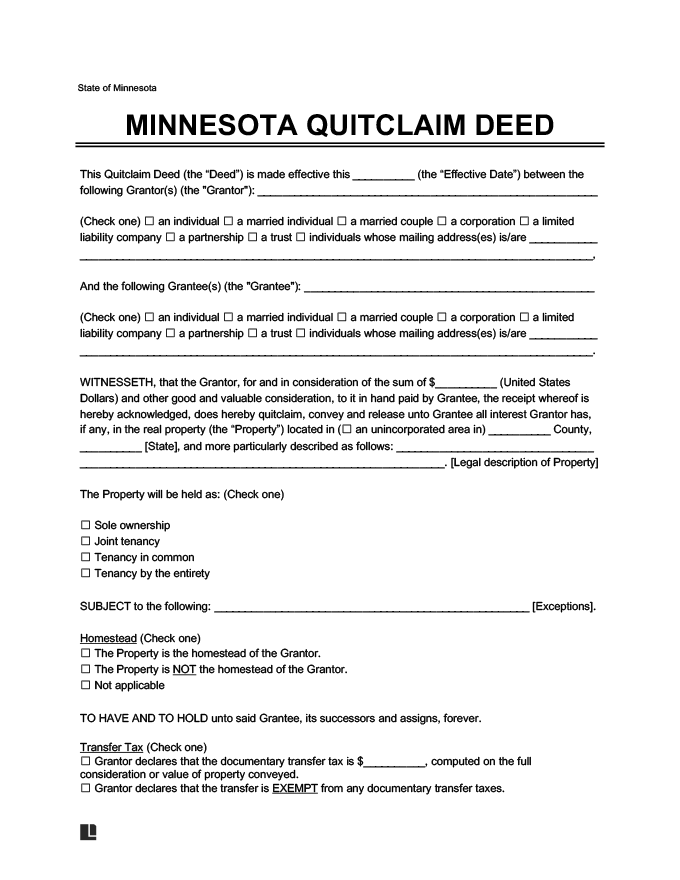A Minnesota quitclaim deed transfers real estate property or modifies an existing deed without warranty of title. It is used in various scenarios, including transferring property between former spouses during divorce or establishing joint tenancy with right of survivorship by adding someone to the deed.
Understanding the specific requirements for executing the document is essential for ensuring a smooth property transfer process.
Legal Framework
Minn. Stat. § 507.06 provides the legal foundation for using a quitclaim and release to convey real estate.
Legal Description
The deed must include a legal description of the property being transferred, per Minn. Stat. § 507.07. Legal descriptions may use a variety of methods to ensure surveyors can locate and identify the real estate interest. Measurements may include the following:
- Lot and block descriptions in reference to a recorded plat.
- Sectional land descriptions from the US Public Land Survey.
- Fractions of a parcel.
- Metes and bounds.
Signing
- Per Minn. Stat. § 507.24.2, a quitclaim deed must include the original signature of the grantor and an acknowledgment from a notary or other approved officer under Minn. Stat. § 507.24.1.
- An electronic signature may be accepted, consistent with Minn. Stat. §§ 507.0941 to 507.0948, inclusive.
- Spouses who share a homestead property with the grantor must also sign the deed, per Minn. Stat. § 507.02.
Terminology
- Minn. Stat. § 507.07 establishes basic statutory language for quitclaim deeds. While it is not necessary to use the exact terminology, your document should include the phrase “conveys and quitclaims” or similar language.
- You should note that the property is conveyed without covenants or warranty of title.
Additional Documents
- For property transfers with more than $3,000 consideration, you must include a certificate of value (Minn. Stat. § 272.115). You can file the form electronically using the eCRV form on the Minnesota Department of Revenue website.
- The county recorder cannot file your quitclaim deed over $3,000 unless it is accompanied by a notice from the county auditor acknowledging receipt of the eCRV form. If your transfer is exempt from deed tax, per Minn. Stat. § 287.22, you must indicate state the exemption directly on the deed.
- The grantor may also be required to submit a certificate disclosing the location and status of wells on the property (Minn. Stat. § 103I.235). You may be exempt from the well disclosure certificate if you are unaware of any wells on the property. In that case, you can simply state the following in the body of the deed: “The seller certifies that the Seller does not know of any wells on the described real property.”
Filing
- Deeds must be registered with the Office of the County Recorder in the county where the real estate is located (Minn. Stat. § 507.34). If the property is in more than one county, a deed must be recorded in each of those counties where the property is situated.
- The grantor may be assessed deed tax if the deed transfers real estate ownership (Minn. Stat. § 287.21). In addition, the county recorder may assess a $5.00 agricultural land preservation fee in certain counties (Minn. Stat. § 40A.152).
Validity Requirements
Minn. Stat. § 507.093 outlines formatting standards for recorded documents. To avoid filing delays or additional fees, your deed should meet the following guidelines:
- Printed, typed, or computer-generated in black ink in no smaller than 8-point font.
- Printed on white paper of at least 20-pound weight, no larger than 8 ½ in. x 14 in.
- Blank 3 in. space at the top of the first page.
- ½ in. margins for the rest of the document.
- The document title prominently displayed below the blank space on the first page.
- No additional affixed or attached sheets obscuring the form.
- Sufficiently legible to create a readable copy using the county recorder’s chosen method.
Content Requirements
For appropriate filing, quitclaim deeds must include the following information:
- Deed preparer name and address (Minn. Stat. § 507.091).
- Grantee address for property tax statements (Minn. Stat. § 507.092).
- Grantor and grantee names (Minn. Stat. § 507.07).
- The legal description of the real estate interest being conveyed.
- Transfer clause conveying the property to the new owner.
- Statement of deed tax owed or exemption (Minn. Stat. § 287.241).
- Designated transfer statement, if applicable (Minn. Stat. § 272.115.6).
- Well disclosure statement, if applicable (Minn. Stat. § 103I.235).
Quitclaim Deeds vs. Other Property Transfer Methods
| Quitclaim Deed | Conveys property from the current owner to the recipient without warranty of title. If title issues arise, the grantee is fully liable and cannot sue the grantor for damages. |
| General Warranty Deed | Transfers property from the grantor with a full warranty of title. Any ownership problems or title defects derived from any point in the property’s history are the grantor's responsibility. |
| Limited Warranty Deed | Transfers property with partial warranty of title. The grantor accepts responsibility for current title or ownership issues. Any issues prior to their ownership are the grantee’s responsibility. |
| Title Insurance | For a premium, the grantee can secure title insurance to cover losses from undisclosed title defects that arise following a property transfer via a quitclaim or limited warranty deed. |
| Estate Planning Deed | The property owner can transfer property through a living trust or transfer-on-death (TOD) deed designed to convey the real property to a beneficiary upon the owner’s death. |
| Co-Ownership | Allows a property owner to share real property interest with another party, such as a spouse. When one owner dies, their share of the property passes to the surviving owner. |
